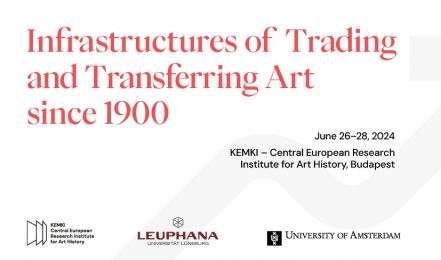‘monument’
Tükörképben rögzített művészet
Conference on the Legacy of István Ferenczy The Museum of Fine Arts – Central European Research Institute for Art History Archive and Documentation Centre are organizing a one-day conference on István Ferenczy entitled Art Preserved in a Mirror Image . The invited speakers will be analyzing one of the most important set of objects within the KEMKI ADK collection: the series of daguerreotypes …
Call for Papers
… limited to: State involvement: Government initiatives, regulations, commissions (e.g., for monumental art, murals), guaranteed purchases, “soft power” politics, and foreign currency needs. State ideologies and political agendas: censorship, restrictions, manipulation, promotion or marginalisation of specific artists and movements. Trading platforms and networks: Museums, galleries, auction houses, art fairs, collectives, and unconventional venues (e.g., hotels, apartments) …
Egyben látni a nagy egészet. Tanulmányok Konecsni György munkásságáról
… explored works ranges from tourism-oriented, commercial and political posters to public art, from monumental-scale historicist paintings to abstract expressionist works, from stamp designs to literary illustrations, from caricatures to sgraffito art, from inventive typographic solutions to experimental surface design techniques. (Excerpt from the foreword by David Fehér) The participants of the book launch: Katalin Bakos (co-editor, former colleague of the Museum of Fine Arts – …
CFP: Infrastructures of Trading and Transferring Art since 1900
… and online platforms; State involvement in trading and transferring art, such as commissioning monumental art/murals, guaranteed buying, soft power cultural politics, censorship; Communication for trading and transferring art, such as art critique or catalogue raisonné writing by dealers, advertisement or PR; Logistics and shipping of trading and transferring art Finances of trading and transferring art, such as collateralization or tax deduction; Illicit or unethical trading …
Megrendelt emlékezet: magyar kiállítások Auschwitzban 1960/1965
… works of art exhibited at the first Hungarian exhibition in Auschwitz in 1960 as well as a monumental fine arts collection commissioned for the 1965 permanent exhibition at the same venue. With the addition of the earliest Hungarian artworks dealing with the Roma Holocaust, the current exhibition highlights the absence of the issue from the 1960s shows. The exhibition takes place at the Galeria Centralis of the Blinken OSA Archivum in Budapest, which is the same institution that …




